24 feb 2018
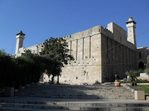
Hebron marks, on Sunday, 24 years since the Ibrahimi mosque massacre took place, when an Israeli settler opened fire at Muslims observing the dawn prayers on a Ramadan morning, killing 29 worshippers and injuring 150 others before he was caught and killed by the crowds.
The settler, an American-Israeli physician identified as Barouch Goldstein, who resided in the ultra-fanatic Kiryat Arba settlement in Hebron, walked into the mosque as a large number of Muslim Ramadan worshippers, mainly elderly, were praying and opened fire at random from his Israeli army-issued machine gun leading to the large number of deaths and injuries.
To make matters worse, Israeli soldiers, who were in the vicinity of the mosque, closed the doors to the mosque and prevented the worshippers from running for their lives. They also prevented people from outside to enter it to help in evacuating the dead and wounded.
Residents who wanted to reach the mosque, and those inside, fought with the soldiers, leaving an additional number dead and injured.
Later, related violence raised the number of Palestinians killed on that day to 50, in Hebron alone, and to 60, adding those killed in confrontations that broke out elsewhere in the West Bank, against Israeli occupation forces.
WAFA additionally reports that, immediately following the massacre, Israel decided to punish the victims by closing down the old town of Hebron, where the Ibrahimi mosque is located, for six months.
An all-Israeli committee was formed to probe the massacre, instead of punishing the settlers, to divide the mosque between Muslims and Jews, and to close down several commercial streets, most famously Shuhada Street, which remains closed for Palestinians until today.
Army checkpoints were also set up to restrict the movement of Palestinians, while Israeli settlers continued to move freely and without any restrictions.
The new facts on the ground created after the massacre to punish the victims are still in place until today.
Wiki article: Cave of the Patriarchs Massacre
The settler, an American-Israeli physician identified as Barouch Goldstein, who resided in the ultra-fanatic Kiryat Arba settlement in Hebron, walked into the mosque as a large number of Muslim Ramadan worshippers, mainly elderly, were praying and opened fire at random from his Israeli army-issued machine gun leading to the large number of deaths and injuries.
To make matters worse, Israeli soldiers, who were in the vicinity of the mosque, closed the doors to the mosque and prevented the worshippers from running for their lives. They also prevented people from outside to enter it to help in evacuating the dead and wounded.
Residents who wanted to reach the mosque, and those inside, fought with the soldiers, leaving an additional number dead and injured.
Later, related violence raised the number of Palestinians killed on that day to 50, in Hebron alone, and to 60, adding those killed in confrontations that broke out elsewhere in the West Bank, against Israeli occupation forces.
WAFA additionally reports that, immediately following the massacre, Israel decided to punish the victims by closing down the old town of Hebron, where the Ibrahimi mosque is located, for six months.
An all-Israeli committee was formed to probe the massacre, instead of punishing the settlers, to divide the mosque between Muslims and Jews, and to close down several commercial streets, most famously Shuhada Street, which remains closed for Palestinians until today.
Army checkpoints were also set up to restrict the movement of Palestinians, while Israeli settlers continued to move freely and without any restrictions.
The new facts on the ground created after the massacre to punish the victims are still in place until today.
Wiki article: Cave of the Patriarchs Massacre
23 feb 2018
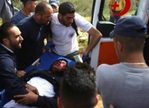
Israeli soldiers resorted, Friday, to the excessive use of force against Palestinian protesters across the occupied West Bank and the Gaza Strip, causing scores of injuries, as the protesters held their weekly processions against the Annexation Wall and Colonies, and for the twelfth consecutive week, marched against the illegal U.S. recognition of occupied Jerusalem as the unified capital of Israel, in violation of International Law and numerous United Nations and Security Council resolutions.
The soldiers fired dozens of live rounds, rubber-coated steel bullets, gas bombs and concussion grenades at the protesters, causing dozens of injuries.
In the al-‘Isawiya town, in the center of occupied Jerusalem, the soldiers attacked nonviolent protesters as they matched near the western entrance of the town.
Dozens of soldiers were deployed in the village, and around it, and installed many roadblocks.
In Ramallah, in central West Bank, the soldiers attacked protester who matched in the al-Mazra’a al-Gharbiyya village, northwest of the city, marking the 49th anniversary of the establishment of the Democratic Front for the Liberation of Palestine (DFLP).
The soldiers fired dozens of gas bombs at the nonviolent protesters, causing many to suffer the effects of teargas inhalation, in addition to causing fires in olive orchards.
The protest was held against a recent Israeli decision, illegally confiscating large swaths of privately-owned Palestinian lands to pave a new segregated road for illegal colonizers, northwest of Ramallah.
In addition, the soldiers caused many Palestinians to suffer the severe effects of teargas inhalation near the main entrance of al-Biereh city, near Ramallah, while many youngsters hurled stones and empty bottles at them.
In related news, the soldiers shot and moderately injured a child with live rounds in his leg, in the al-Janiya village, west of Ramallah, before he was rushed to Palestinian Medical Complex.
Also in Ramallah, the soldiers attacked the weekly procession against the Annexation Wall and colonies, in Bil’in village, west of the city.
In Hebron, in southern West Bank, the soldiers attacked dozens of Palestinians, who marched in the Old City, marking the establishment of the DFLP and in commemoration of the Ibrahimi Mosque massacre, when Israeli terrorist Baruch Goldstein opened fire on worshipers in the holy site, killing 29 and wounded dozens.
The army fired dozens of gas bombs and concussion grenades at the protesters and prevented them from reaching the mosque.
In Nablus, in northern West Bank, the soldiers shot two Palestinians with live fire, and two others with rubber-coated steel bullets, after the army attacked protesters, who marched near Huwwara military roadblock, and at the main entrance of Beita town.
In addition, illegal Israeli colonizers of Bracha outpost, which was built on private Palestinian lands south of Nablus, attacked many homes and fired live rounds.
Furthermore, the soldiers attacked protesters in Kufur Qaddoum town, in the northern West bank governorate of Qalqilia, and fired many rubber-coated steel bullets, gas bombs and concussion grenades at them.
In the Gaza Strip, medical sources have reported that the soldiers shot four Palestinians near Nahal Oz military base, east of Gaza city, before medics rushed them to a local hospital.
They added that the soldiers shot three Palestinians near the Shuahada Graveyard, east of Jabalia refugee camp, in northern Gaza, and three others east of Khan Younis, in southern Gaza.
Dozens of Palestinians also suffered the severe effects of teargas inhalation in several parts of the coastal region.
The soldiers fired dozens of live rounds, rubber-coated steel bullets, gas bombs and concussion grenades at the protesters, causing dozens of injuries.
In the al-‘Isawiya town, in the center of occupied Jerusalem, the soldiers attacked nonviolent protesters as they matched near the western entrance of the town.
Dozens of soldiers were deployed in the village, and around it, and installed many roadblocks.
In Ramallah, in central West Bank, the soldiers attacked protester who matched in the al-Mazra’a al-Gharbiyya village, northwest of the city, marking the 49th anniversary of the establishment of the Democratic Front for the Liberation of Palestine (DFLP).
The soldiers fired dozens of gas bombs at the nonviolent protesters, causing many to suffer the effects of teargas inhalation, in addition to causing fires in olive orchards.
The protest was held against a recent Israeli decision, illegally confiscating large swaths of privately-owned Palestinian lands to pave a new segregated road for illegal colonizers, northwest of Ramallah.
In addition, the soldiers caused many Palestinians to suffer the severe effects of teargas inhalation near the main entrance of al-Biereh city, near Ramallah, while many youngsters hurled stones and empty bottles at them.
In related news, the soldiers shot and moderately injured a child with live rounds in his leg, in the al-Janiya village, west of Ramallah, before he was rushed to Palestinian Medical Complex.
Also in Ramallah, the soldiers attacked the weekly procession against the Annexation Wall and colonies, in Bil’in village, west of the city.
In Hebron, in southern West Bank, the soldiers attacked dozens of Palestinians, who marched in the Old City, marking the establishment of the DFLP and in commemoration of the Ibrahimi Mosque massacre, when Israeli terrorist Baruch Goldstein opened fire on worshipers in the holy site, killing 29 and wounded dozens.
The army fired dozens of gas bombs and concussion grenades at the protesters and prevented them from reaching the mosque.
In Nablus, in northern West Bank, the soldiers shot two Palestinians with live fire, and two others with rubber-coated steel bullets, after the army attacked protesters, who marched near Huwwara military roadblock, and at the main entrance of Beita town.
In addition, illegal Israeli colonizers of Bracha outpost, which was built on private Palestinian lands south of Nablus, attacked many homes and fired live rounds.
Furthermore, the soldiers attacked protesters in Kufur Qaddoum town, in the northern West bank governorate of Qalqilia, and fired many rubber-coated steel bullets, gas bombs and concussion grenades at them.
In the Gaza Strip, medical sources have reported that the soldiers shot four Palestinians near Nahal Oz military base, east of Gaza city, before medics rushed them to a local hospital.
They added that the soldiers shot three Palestinians near the Shuahada Graveyard, east of Jabalia refugee camp, in northern Gaza, and three others east of Khan Younis, in southern Gaza.
Dozens of Palestinians also suffered the severe effects of teargas inhalation in several parts of the coastal region.
16 feb 2018
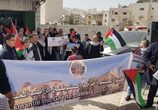
Israeli soldiers attacked, Friday, dozens of nonviolent Palestinian protesters, and abducted a teenage boy, in the Old City of Hebron, in the southern part of the West Bank.
The procession, which was organized by “Dismantle the Hebron Ghetto” campaign, was carried out demanding the removal of Israeli colonizers, living in illegal colonies and outposts in Hebron.
They chanted against the ongoing violations carried out by the army against the Ibrahimi Mosque in the city, for the 24th consecutive year since the Ibrahimi Mosque Massacre, which was committed by Baruch Goldstein on February 25th, 1994.
The soldiers started firing gas bombs and concussion grenades at the nonviolent protesters, just as they entered the Shallala Street area, causing dozens to suffer the severe effects of teargas inhalation.
Several Palestinian youngsters hurled stones at the soldiers, while some threw the gas bombs back at the army.
In addition, the soldiers abducted Ma’moun an-Natsha, 16, from Bab az-Zawiya area in the Old City, while he was walking back home in Tal Romedia.
It is worth mentioning that Ma’moun’s father was a political prisoner, who was released a week ago, after being held by Israel for 18 months.
Goldstein, a US-born Israeli military physician walked into the Ibrahimi mosque in Hebron armed with an assault rifle during the holy month of Ramadan, and hundreds of Palestinians were crammed inside, bowed in prayer, before he opened fire, killing 29, and wounding more than a hundred others.
The procession, which was organized by “Dismantle the Hebron Ghetto” campaign, was carried out demanding the removal of Israeli colonizers, living in illegal colonies and outposts in Hebron.
They chanted against the ongoing violations carried out by the army against the Ibrahimi Mosque in the city, for the 24th consecutive year since the Ibrahimi Mosque Massacre, which was committed by Baruch Goldstein on February 25th, 1994.
The soldiers started firing gas bombs and concussion grenades at the nonviolent protesters, just as they entered the Shallala Street area, causing dozens to suffer the severe effects of teargas inhalation.
Several Palestinian youngsters hurled stones at the soldiers, while some threw the gas bombs back at the army.
In addition, the soldiers abducted Ma’moun an-Natsha, 16, from Bab az-Zawiya area in the Old City, while he was walking back home in Tal Romedia.
It is worth mentioning that Ma’moun’s father was a political prisoner, who was released a week ago, after being held by Israel for 18 months.
Goldstein, a US-born Israeli military physician walked into the Ibrahimi mosque in Hebron armed with an assault rifle during the holy month of Ramadan, and hundreds of Palestinians were crammed inside, bowed in prayer, before he opened fire, killing 29, and wounding more than a hundred others.
2 feb 2018

A national campaign against the siege on al-Khalil Old City has announced the launch of events to commemorate the anniversary of the Ibrahimi Mosque massacre, which occurred in 1994.
Human rights activist Farid al-Atrash said that the campaign called on the Palestinians in the city to participate en masse in the Friday prayer at the Ibrahimi Mosque, which is encircled by barriers and security gates.
Atrash told the Palestinian Information Center (PIC) that “the Old City of al-Khalil and its Ibrahimi Mosque have been under tight siege since the 1994 massacre,” warning of an Israeli plan to Judaize the Mosque and turn it into a synagogue.
He called on the Palestinian citizens in the West Bank to intensify their presence at the Mosque and the Old City to thwart any Israeli plot targeting them.
The Ibrahimi Mosque massacre was a shooting terrorist attack carried out by Jewish settler Baruch Goldstein.
Goldstein was an American immigrant to Israel who was active in the extremist Kach political movement in the nearby Israeli settlement of Kiryat Arba, and he was known to Israeli intelligence. He was found and beaten to death by a crowd soon after the massacre.
The Israeli government has maintained that Goldstein acted alone, but numerous witnesses at the time reported seeing two to three attackers.
Human rights activist Farid al-Atrash said that the campaign called on the Palestinians in the city to participate en masse in the Friday prayer at the Ibrahimi Mosque, which is encircled by barriers and security gates.
Atrash told the Palestinian Information Center (PIC) that “the Old City of al-Khalil and its Ibrahimi Mosque have been under tight siege since the 1994 massacre,” warning of an Israeli plan to Judaize the Mosque and turn it into a synagogue.
He called on the Palestinian citizens in the West Bank to intensify their presence at the Mosque and the Old City to thwart any Israeli plot targeting them.
The Ibrahimi Mosque massacre was a shooting terrorist attack carried out by Jewish settler Baruch Goldstein.
Goldstein was an American immigrant to Israel who was active in the extremist Kach political movement in the nearby Israeli settlement of Kiryat Arba, and he was known to Israeli intelligence. He was found and beaten to death by a crowd soon after the massacre.
The Israeli government has maintained that Goldstein acted alone, but numerous witnesses at the time reported seeing two to three attackers.
30 mar 2017
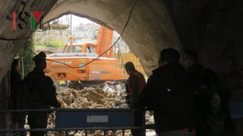
On Wednesday, 29th March, 2017, Israeli forces opened a blocked-off street for the first time in almost two decades to allow long-overdue sewage system works.
The alley in occupied al-Khalil (Hebron), open for less than a day, gave Palestinians the rare opportunity to see Shuhada Street and the illegal settlements which have caused countless closures for the civilian Palestinian population.
Palestinians have been pursuing permission, from the Israeli side, to do this maintenance work for years – with no success.
The market in the Old Town runs almost parallel to Shuhada Street, where the main settlements in the heart of Hebron are located, and where Palestinians are totally prohibited.
As one of the lowest points in the Old City, this area of the “souq” is regularly flooded in winter by rain water and overflowing sewage, as much of the sewage system has been cut off by the illegal settlements.
Despite a one-day ‘permit’ granted by Israeli forces, for work to be undertaken, several delays were caused when Israeli forces would not allow additional maintenance vehicles to enter the area.
Furthermore, the small amount of time granted by the permit only allowed workers to fix a short stretch of sewage pipe immediately beneath the concrete slabs, with other vital works having to be postponed.
Heavily armed Israeli forces were present on site at all times to ‘guard’ the path to what was once a thriving Palestinian market and the main route between north and south al-Khalil. After the Ibrahimi Mosque massacre in 1994 – in which colonial settler Baruch Goldstein gunned down and killed 29 Palestinians and injured more than 120 more when he opened fire with his machine gun during prayers – Israeli forces have slowly but steadily eradicated the Palestinian presence in Shuhada Street. This process has been achieved through broader, ever-increasing restrictions, harassment, and intimidation towards the Palestinian civil population of al-Khalil.
During the maintenance, passing Palestinians could be seen reacting with surprise and stopping to watch the work and take photographs. Sunlight – long hidden by the high cement slabs barricading the street – suddenly flooded the souq from the small archway. For many Palestinians, this brief opening served as a reminder of a time before the severe crackdown on Palestinian human rights by Israeli forces in the aftermath of the massacre. One elderly man demanded the soldiers let him through so he may visit his shop, which remains sealed-up on Shuhada Street, where Palestinian movement is entirely forbidden by Israeli forces, to favor and facilitate settler movement.
The alley in occupied al-Khalil (Hebron), open for less than a day, gave Palestinians the rare opportunity to see Shuhada Street and the illegal settlements which have caused countless closures for the civilian Palestinian population.
Palestinians have been pursuing permission, from the Israeli side, to do this maintenance work for years – with no success.
The market in the Old Town runs almost parallel to Shuhada Street, where the main settlements in the heart of Hebron are located, and where Palestinians are totally prohibited.
As one of the lowest points in the Old City, this area of the “souq” is regularly flooded in winter by rain water and overflowing sewage, as much of the sewage system has been cut off by the illegal settlements.
Despite a one-day ‘permit’ granted by Israeli forces, for work to be undertaken, several delays were caused when Israeli forces would not allow additional maintenance vehicles to enter the area.
Furthermore, the small amount of time granted by the permit only allowed workers to fix a short stretch of sewage pipe immediately beneath the concrete slabs, with other vital works having to be postponed.
Heavily armed Israeli forces were present on site at all times to ‘guard’ the path to what was once a thriving Palestinian market and the main route between north and south al-Khalil. After the Ibrahimi Mosque massacre in 1994 – in which colonial settler Baruch Goldstein gunned down and killed 29 Palestinians and injured more than 120 more when he opened fire with his machine gun during prayers – Israeli forces have slowly but steadily eradicated the Palestinian presence in Shuhada Street. This process has been achieved through broader, ever-increasing restrictions, harassment, and intimidation towards the Palestinian civil population of al-Khalil.
During the maintenance, passing Palestinians could be seen reacting with surprise and stopping to watch the work and take photographs. Sunlight – long hidden by the high cement slabs barricading the street – suddenly flooded the souq from the small archway. For many Palestinians, this brief opening served as a reminder of a time before the severe crackdown on Palestinian human rights by Israeli forces in the aftermath of the massacre. One elderly man demanded the soldiers let him through so he may visit his shop, which remains sealed-up on Shuhada Street, where Palestinian movement is entirely forbidden by Israeli forces, to favor and facilitate settler movement.
26 feb 2017
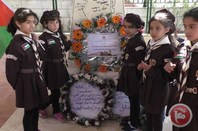
The National Campaign to Lift the Closure of Hebron organized a commemoration of the Ibrahimi Mosque massacre on Sunday with a visit to the graves of the Palestinian victims of the attack, which occurred 23 years ago.
On Feb. 25, 1994, American-born Israeli settler Baruch Goldstein opened fire on Muslim worshipers at the mosque in the southern occupied West Bank city, killing 29 and injuring more than 120.
Hebron Mayor Kamil Hmeid, Fatah party secretary in Hebron Imad Khirwat, head of al-Waqf in Hebron Ismail Abu Halawa, activists, and family members of the victims of the attack attended the event.
Hmeid spoke of the deadly attack and the Israeli restrictions imposed on Palestinians in Hebron in its wake, before saying a prayer for the deceased.
Following the massacre, Israel divided Hebron, with the majority of the city placed under the jurisdiction of the Palestinian Authority, while the Old City and surrounding areas were placed under Israeli military control in a sector known as H2.
Activist Hisham Sharabati called on Palestinians to keep visiting the Ibrahimi Mosque and continue to remember those who died there.
Hebron activists organized a series of events in the past week ahead of the anniversary, including a candlelight vigil and a march calling for the reopening of Shuhada street, which has remained almost entirely closed to Palestinians since the massacre.
On Feb. 25, 1994, American-born Israeli settler Baruch Goldstein opened fire on Muslim worshipers at the mosque in the southern occupied West Bank city, killing 29 and injuring more than 120.
Hebron Mayor Kamil Hmeid, Fatah party secretary in Hebron Imad Khirwat, head of al-Waqf in Hebron Ismail Abu Halawa, activists, and family members of the victims of the attack attended the event.
Hmeid spoke of the deadly attack and the Israeli restrictions imposed on Palestinians in Hebron in its wake, before saying a prayer for the deceased.
Following the massacre, Israel divided Hebron, with the majority of the city placed under the jurisdiction of the Palestinian Authority, while the Old City and surrounding areas were placed under Israeli military control in a sector known as H2.
Activist Hisham Sharabati called on Palestinians to keep visiting the Ibrahimi Mosque and continue to remember those who died there.
Hebron activists organized a series of events in the past week ahead of the anniversary, including a candlelight vigil and a march calling for the reopening of Shuhada street, which has remained almost entirely closed to Palestinians since the massacre.
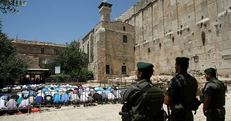
23 years have passed since the Ibrahimi Mosque massacre was committed when the extremist Israeli settler Baruch Goldstein murdered 29 Palestinians and injured 150 others who were performing dawn prayer at the mosque. The massacre is still fresh in the memory of the Palestinian people as one of the most heinous Israeli crimes.
The Old City of al-Khalil shall never forget the massacre which was committed on the 15th Ramadan, 25th February 1994, and constituted a painful stage in the Judaizaion process of the Ibrahimi Mosque.
Bloody memory and escalating anger
The residents of al-Khalil city still recall the incident, the bodies of the murdered and injured worshippers crammed in the mosque, the sound of the gunfire, the blood scattered everywhere, the nonstop movement of ambulances, the families heading to hospitals to recognize their martyrs, the tension and the unprecedented anger at the Israeli occupation forces (IOF).
The massacre began when Goldstein opened fire at about 500 worshippers who were kneeling in prayer at dawn, 29 of whom were killed instantly while 150 were injured. While the Israeli terrorist was trying to refill ammunition to kill more worshippers, he was beaten by the worshippers and killed.
During the massacre, the Israeli soldiers who were present near the doors of the mosque closed its doors to prevent worshippers from escaping and prevent those coming from outside from entering the mosque's courtyards to rescue the injured.
Following the massacre, a number of other Palestinians were shot dead by Israeli soldiers outside the mosque and during the funerals of the martyrs raising the total number of martyrs to 50 including the 29 who were killed in the mosque.
On the same day, confrontations with Israeli soldiers and anger escalated in al-Khalil and all Palestinian cities resulting in the martyrdom of 60 Palestinians.
Violations continue
The IOF closed the Ibrahimi Mosque and the Old City for 6 months for alleged investigations, and formed the unilateral Shamgar committee to investigate the massacre and its causes.
The committee came out at the time with a number of recommendations, the first of which was dividing the Ibrahimi Mosque to two parts and granting Jews sovereignty over the largest part which represents 60% in a bid to Judaize the mosque.
The Israeli committee imposed more hardships on the Palestinian citizens in the Old City, placed tight security at the entrances of the mosque and banned the Adhan (call of prayer) in the Ibrahimi Mosque many times.
The usurped part of the mosque includes shrines and tombs of prophets including the tombs of Yaqoub and his wife, Ibrahim and his wife Sarah, and Yusuf as well as the mosque's courtyard.
Later on, the Israeli occupation authorities (IOA) placed 26 cameras, electronic gates, checkpoints and voice and image sensors at all entrances of the mosque in an area of no more than 200 square meters, and closed all the roads leading to the Ibrahimi Mosque except for one gate with strict security measures. The IOA also closed a number of markets and streets in al-Khalil in an attempt to isolate the Old City.
The Israeli Shamgar committee recommended a complete opening of the mosque for 10 days annually only for Muslims and other 10 days only for Jews.
Who is Goldstein?
Baruch Goldstein, who was 42 years old when he committed the massacre, is one of the founders of the extremist Kach Movement. He emigrated from the United States in 1980 and lived in Kiryat Arba settlement which is built inside al-Khalil city.
When the Israeli Rabbi Moshe Levinger was asked whether he felt sorry for those who were killed at the hands of Goldstein, he said that an Arab's life is equal to that of a fly as far as he was concerned.
Most of the Jews in Israel consider Goldstein, whose grave was turned into a shrine, a saint. Israel has allocated a number of honor guards to perform military salute before his grave every morning.
The Old City of al-Khalil shall never forget the massacre which was committed on the 15th Ramadan, 25th February 1994, and constituted a painful stage in the Judaizaion process of the Ibrahimi Mosque.
Bloody memory and escalating anger
The residents of al-Khalil city still recall the incident, the bodies of the murdered and injured worshippers crammed in the mosque, the sound of the gunfire, the blood scattered everywhere, the nonstop movement of ambulances, the families heading to hospitals to recognize their martyrs, the tension and the unprecedented anger at the Israeli occupation forces (IOF).
The massacre began when Goldstein opened fire at about 500 worshippers who were kneeling in prayer at dawn, 29 of whom were killed instantly while 150 were injured. While the Israeli terrorist was trying to refill ammunition to kill more worshippers, he was beaten by the worshippers and killed.
During the massacre, the Israeli soldiers who were present near the doors of the mosque closed its doors to prevent worshippers from escaping and prevent those coming from outside from entering the mosque's courtyards to rescue the injured.
Following the massacre, a number of other Palestinians were shot dead by Israeli soldiers outside the mosque and during the funerals of the martyrs raising the total number of martyrs to 50 including the 29 who were killed in the mosque.
On the same day, confrontations with Israeli soldiers and anger escalated in al-Khalil and all Palestinian cities resulting in the martyrdom of 60 Palestinians.
Violations continue
The IOF closed the Ibrahimi Mosque and the Old City for 6 months for alleged investigations, and formed the unilateral Shamgar committee to investigate the massacre and its causes.
The committee came out at the time with a number of recommendations, the first of which was dividing the Ibrahimi Mosque to two parts and granting Jews sovereignty over the largest part which represents 60% in a bid to Judaize the mosque.
The Israeli committee imposed more hardships on the Palestinian citizens in the Old City, placed tight security at the entrances of the mosque and banned the Adhan (call of prayer) in the Ibrahimi Mosque many times.
The usurped part of the mosque includes shrines and tombs of prophets including the tombs of Yaqoub and his wife, Ibrahim and his wife Sarah, and Yusuf as well as the mosque's courtyard.
Later on, the Israeli occupation authorities (IOA) placed 26 cameras, electronic gates, checkpoints and voice and image sensors at all entrances of the mosque in an area of no more than 200 square meters, and closed all the roads leading to the Ibrahimi Mosque except for one gate with strict security measures. The IOA also closed a number of markets and streets in al-Khalil in an attempt to isolate the Old City.
The Israeli Shamgar committee recommended a complete opening of the mosque for 10 days annually only for Muslims and other 10 days only for Jews.
Who is Goldstein?
Baruch Goldstein, who was 42 years old when he committed the massacre, is one of the founders of the extremist Kach Movement. He emigrated from the United States in 1980 and lived in Kiryat Arba settlement which is built inside al-Khalil city.
When the Israeli Rabbi Moshe Levinger was asked whether he felt sorry for those who were killed at the hands of Goldstein, he said that an Arab's life is equal to that of a fly as far as he was concerned.
Most of the Jews in Israel consider Goldstein, whose grave was turned into a shrine, a saint. Israel has allocated a number of honor guards to perform military salute before his grave every morning.
